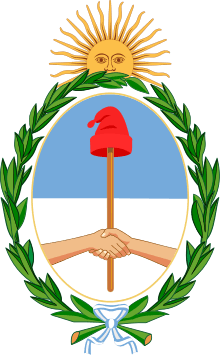Argentine legislative election, 2017
 |
| This article is part of a series on the politics and government of Argentina |
| Foreign relations |
Legislative elections will be held in Argentina on October 29, 2017.
Background
The elections will take place during the presidency of Mauricio Macri whose Cambiemos coalition also controls the city of Buenos Aires and Buenos Aires Province. As Cambiemos is a new party with few noteworthy political figures, several members of the cabinet may be asked to resign from it and run for Congress in their respective districts instead.[1]
Peronist factions are divided in two main groups; the Front for Victory, led by the former president Cristina Fernández de Kirchner, leads the parliamentary opposition to Macri's administration. Another group is composed of politicians from the Justicialist Party and the Renewal Front.
Electoral system
The 257 members of the Chamber of Deputies are elected by proportional representation in 24 multi-member constituencies based on the provinces (plus Buenos Aires). Seats are allocated using the d'Hondt method with a 3% electoral threshold.[2]
The 72 members of the Senate are elected in the same 24 constituencies, with three seats in each. The party receiving the most votes in each constituency wins two seats, with the third seat awarded to the second-placed party.[3]
Possible candidates
- Cambiemos
- Esteban Bullrich
- Carolina Stanley
- Jorge Triaca
- Julio Martínez
- Ricardo Buryaile
- Patricia Bullrich
- José Cano
- Elisa Carrió
- Front for Victory
- Cristina Fernández de Kirchner
- Daniel Scioli
- Máximo Kirchner
- Verónica Magario
- Florencio Randazzo
- Axel Kicillof
- Mariano Recalde
- Juliana Di Tullio
- Fernando Espinoza
- Julián Domínguez
- Daniel Filmus
- Jorge Taiana
- Other Peronists
References
- ↑ Santiago Dapelo (June 12, 2016). "Macri activa a medio gabinete para las elecciones de 2017" [Macri turns on half the cabinet for the 2017 elections] (in Spanish). La Nación. Retrieved June 27, 2016.
- ↑ Electoral system Inter-Parliamentary Union
- ↑ Electoral system Inter-Parliamentary Union